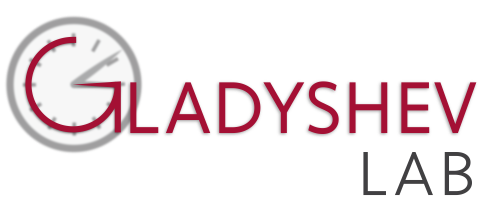2022 Articles
Petra A Tsuji, Didac Santesmasses, Byeong J Lee, Vadim N Gladyshev, Dolph L Hatfield (2022). Historical Roles of Selenium and Selenoproteins in Health and Development: The Good, the Bad and the Ugly. Int J Mol Sci. doi: 10.3390/ijms23010005
Huafeng Wang, Qianhui Dou, Kyung Jo Jeong, Jungmin Choi, Vadim N Gladyshev, Jean-Ju Chung (2022). Redox regulation by TXNRD3 during epididymal maturation underlies capacitation-associated mitochondrial activity and sperm motility in mice. J Biol Chem. doi: 10.1016/j.jbc.2022.102077
Stephan Emmrich, Alexandre Trapp, Frances Tolibzoda Zakusilo, Maggie E Straight, Albert K Ying, Alexander Tyshkovskiy, Marco Mariotti, Spencer Gray, Zhihui Zhang, Michael G Drage, Masaki Takasugi, Jan-Henning Klusmann , Vadim N Gladyshev, Andrei Seluanov , Vera Gorbunova (2022). Characterization of naked mole-rat hematopoiesis reveals unique stem and progenitor cell patterns and neotenic traits. EMBO J doi: 10.15252/embj.2021109694
Didac Santesmasses, Vadim N Gladyshev (2022). Selenocysteine Machinery Primarily Supports TXNRD1 and GPX4 Functions and Together They Are Functionally Linked with SCD and PRDX6. Biomolecules. Biomolecules doi: 10.3390/biom12081049
Qianhui Dou, Anton A Turanov, Marco Mariotti, Jae Yeon Hwang, Huafeng Wang, Sang-Goo Lee, Joao A Paulo, Sun Hee Yim, Stephen P Gygi, Jean-Ju Chung, Vadim N Gladyshev (2022). Selenoprotein TXNRD3 supports male fertility via the redox regulation of spermatogenesis. J Biol Chem doi: 10.1016/j.jbc.2022.102183
Lionel Tarrago, Alaattin Kaya, Hwa-Young Kim, Bruno Manta, Byung-Cheon Lee , Vadim N Gladyshev(2022) The selenoprotein methionine sulfoxide reductase B1 (MSRB1). Free Radic Biol Med doi: 10.1016/j.freeradbiomed.2022.08.043
Mahdi Moqri, Andrea Cipriano, Daniel Nachun, Tara Murty, Guilherme de Sena Brandine, Sajede Rasouli, Andrei Tarkhov, Karolina A. Aberg, Edwin van den Oord, Wanding Zhou, Andrew Smith, Crystal Mackall, Vadim Gladyshev, Steve Horvath, Michael P. Snyder, Vittorio Sebastiano (2022) PRC2 clock: a universal epigenetic biomarker of aging and rejuvenation. bioRxiv doi: https://doi.org/10.1101/2022.06.03.49460
Kejun Ying, Hanna Liu, Andrei E. Tarkhov, Ake T. Lu, Steve Horvath, Zoltán Kutalik, Xia Shen, Vadim N. Gladyshev (2022) Causal Epigenetic Age Uncouples Damage and Adaptation. bioRxiv doi: https://doi.org/10.1101/2022.10.07.511382.
Andrei E. Tarkhov, Thomas Lindstrom-Vautrin, Sirui Zhang, Kejun Ying, Mahdi Moqri, Bohan Zhang, Vadim N. Gladyshev (2022) Nature of epigenetic aging from a single-cell perspective. bioRxiv doi: https://doi.org/10.1101/2022.09.26.509592.
Jeyoung Bang, Donghyun Kang, Jisu Jung, Tack-Jin Yoo, Myoung Sup Shim, Vadim N Gladyshev, Petra A Tsuji, Dolph L Hatfield, Jin-Hong Kim, Byeong Jae Lee (2022) SEPHS1: Its evolution, function and roles in development and diseases. Arch Biochem Biophys doi: 10.1016/j.abb.2022.109426.
Bohan Zhang, Andrei E. Tarkhov, Wil Ratzan, Kejun Ying, Mahdi Moqri, Jesse R. Poganik, Benjamin Barre, Alexandre Trapp, Joseph A. Zoller, Amin Haghani, Steve Horvath, Leonid Peshkin, Vadim N. Gladyshev(2022) Epigenetic profiling and incidence of disrupted development point to gastrulation as aging ground zero in Xenopus laevis. bioRxive doi: https://doi.org/10.1101/2022.08.02.502559
Jesse R. Poganik, Bohan Zhang, Gurpreet S. Baht, Csaba Kerepesi, Sun Hee Yim, Ake T. Lu, Amin Haghani, Tong Gong, Anna M. Hedman, Ellika Andolf, Göran Pershagen, Catarina Almqvist, James P. White, Steve Horvath, Vadim N. Gladyshev (2022) Biological age is increased by stress and restored upon recovery. bioRxive doi:https://doi.org/10.1101/2022.05.04.490686
Shindyapina AV, Cho Y, Kaya A, Tyshkovskiy A, Castro JP, Deik A, Gordevicius J, Poganik JR, Clish CB, Horvath S, Peshkin L, Gladyshev VN (2022) Rapamycin treatment during development extends life span and health span of male mice and Daphnia magna. Science Advances 8, 37.
Kerepesi C, Meer MV, Ablaeva J, Amoroso VG, Lee SG, Zhang B, Gerashchenko MV, Trapp A, Yim SH, Lu AT, Levine ME, Seluanov A, Horvath S, Park TJ, Gorbunova V, Gladyshev VN (2022) Epigenetic aging of the demographically non-aging naked mole-rat. Nature Communications 13, 355.
Zhang B, Trapp A, Kerepesi C, Gladyshev VN (2022) Emerging rejuvenation strategies-Reducing the biological age. Aging Cell 21, e13538.
Mariotti M, Kerepesi C, Oliveros W, Mele M, Gladyshev VN (2022) Deterioration of the human transcriptome with age due to increasing intron retention and spurious splicing. bioRxiv, 10.1101/2022.03.14.484341
Meron E, Thaysen M, Angeli S, Antebi A, Barzilai N, Baur JA, Bekker-Jensen S, Birkisdottir M, Bischof E, Bruening J, Brunet A, Buchwalter A, Cabreiro F, Fortney K, Freund A, Georgievskaya A, Gladyshev VN, Glass D, Golato T, Gorbunova V, Hoejimakers J, Houtkooper RH, Jager S, Jaksch F, Janssens G, Jensen MB, Kaeberlein M, Karsenty G, de Keizer P, Kennedy B, Kirkland JL, Kjaer M, Kroemer G, Lee KF, Lemaitre JM, Liaskos D, Longo VD, Lu YX, MacArthur MR, Maier AB, Manakanatas C, Mitchell SJ, Moskalev A, Niedernhofer L, Ozerov I, Partridge L, Passegué E, Petr MA, Peyer J, Radenkovic D, Rando TA, Rattan S, Riedel CG, Rudolph L, Ai R, Serrano M, Schumacher B, Sinclair DA, Smith R, Suh Y, Taub P, Trapp A, Trendelenburg AU, Valenzano DR, Verburgh K, Verdin E, Vijg J, Westendorp RGJ, Zonari A, Bakula D, Zhavoronkov A, Scheibye-Knudsen M (2022) Meeting Report: Aging Research and Drug Discovery. Aging 14, 530-543.
Kang D, Lee J, Jung J, Carlson BA, Chang MJ, Chang CB, Kang SB, Lee BC, Gladyshev VN, Hatfield DL, Lee BJ, Kim JH (2022) Selenophosphate synthetase 1 deficiency exacerbates osteoarthritis by dysregulating redox homeostasis. Nature Communications 13, 779.
Lee HM, Choi DW, Kim S, Lee A, Kim M, Roh YJ, Jo YH, Cho HY, Lee HJ, Lee SR, Tarrago L, Gladyshev VN, Kim JH, Lee BC (2022) Biosensor-Linked Immunosorbent Assay for the Quantification of Methionine Oxidation in Target Proteins. ACS Sensors 7, 131-141.
Tian R, Han K, Geng Y, Yang C, Shi C, Thomas PB, Pearce C, Moffatt K, Ma S, Xu S, Yang G, Zhou X, Gladyshev VN, Liu X, Fisher DO, Chopin LK, Leiner NO, Baker AM, Fan G, Seim I (2022) A chromosome-level genome of Antechinus flavipes provides a reference for an Australian marsupial genus with male death after mating. Molecular Ecology Resources 22, 740-754.



